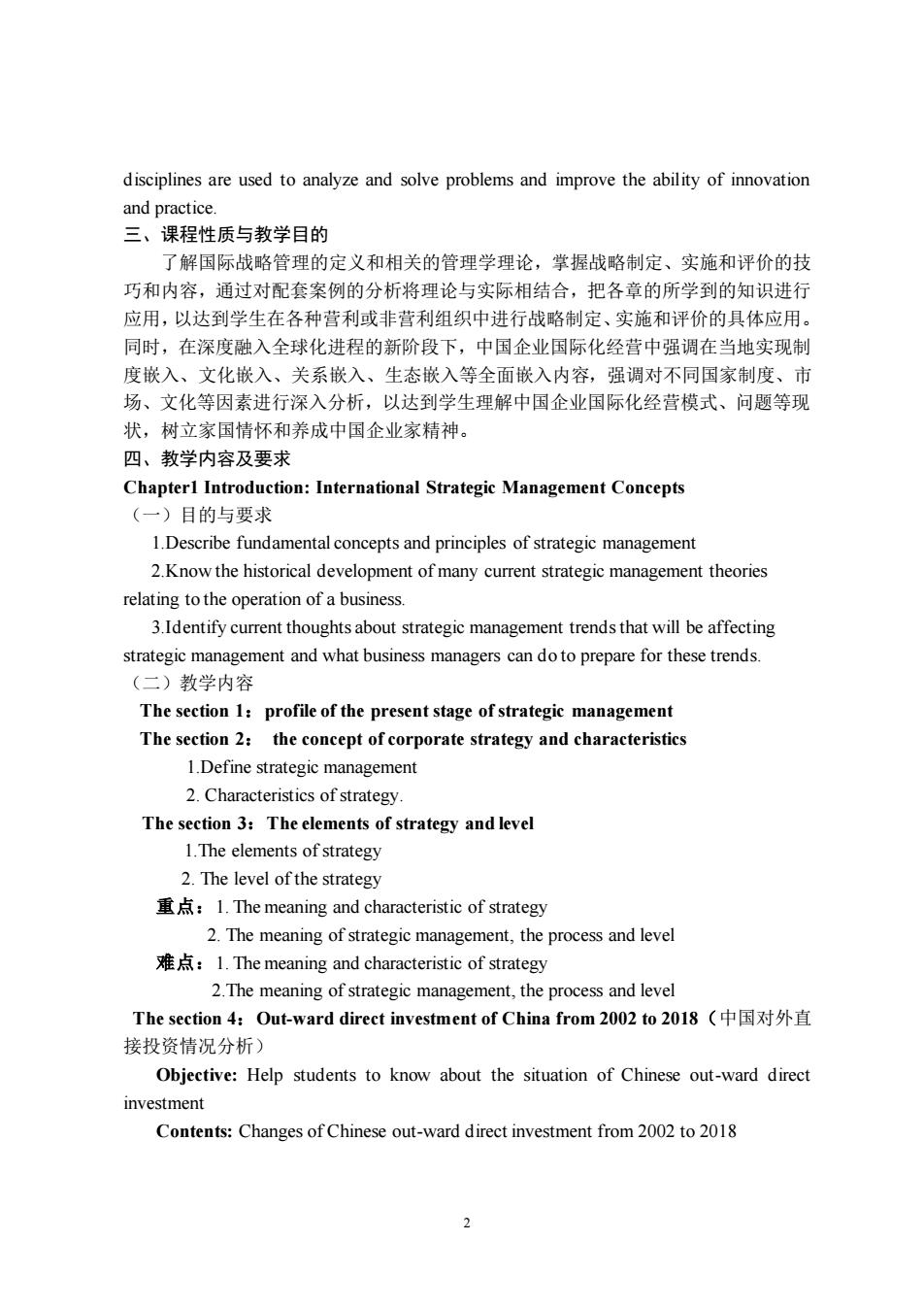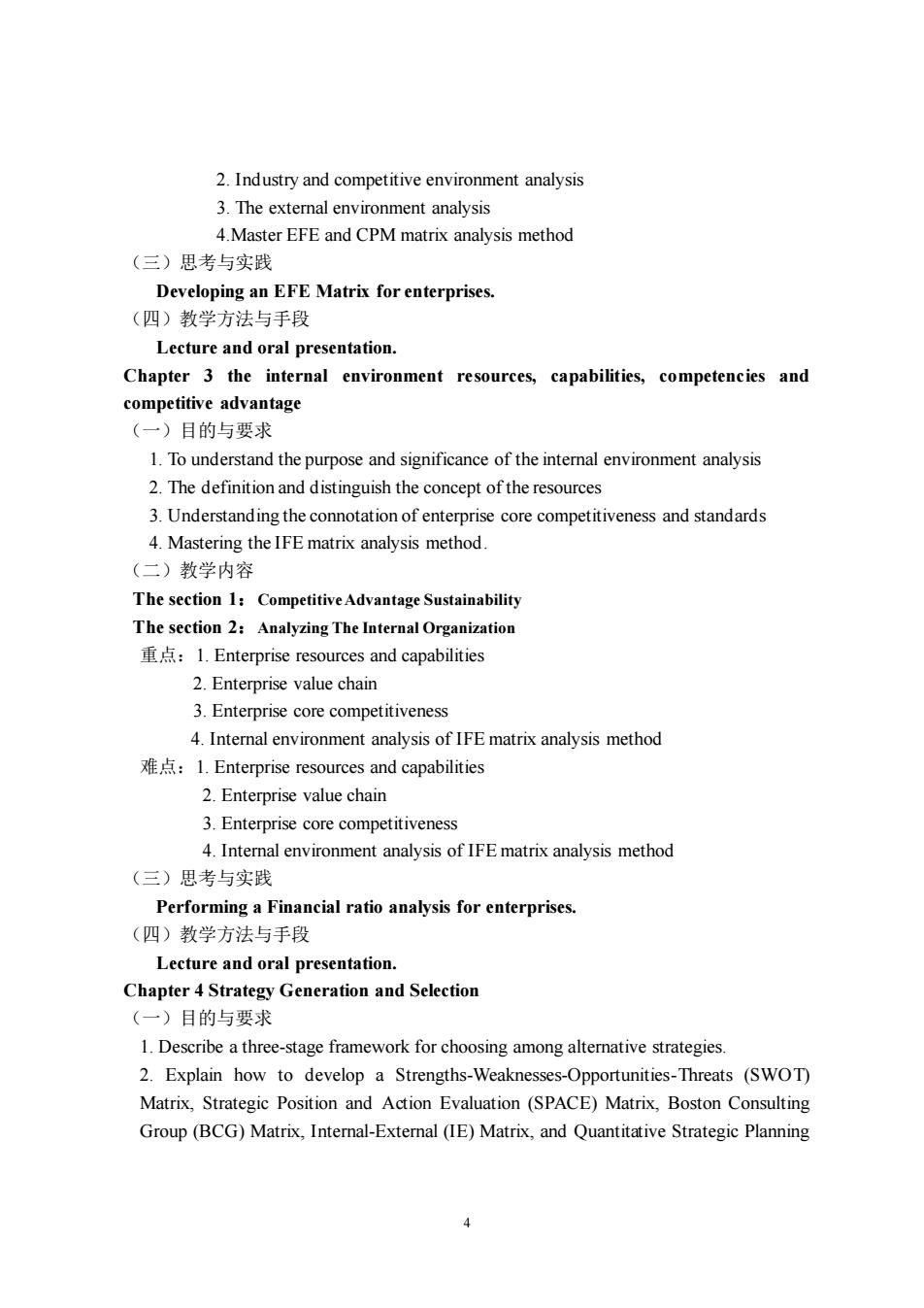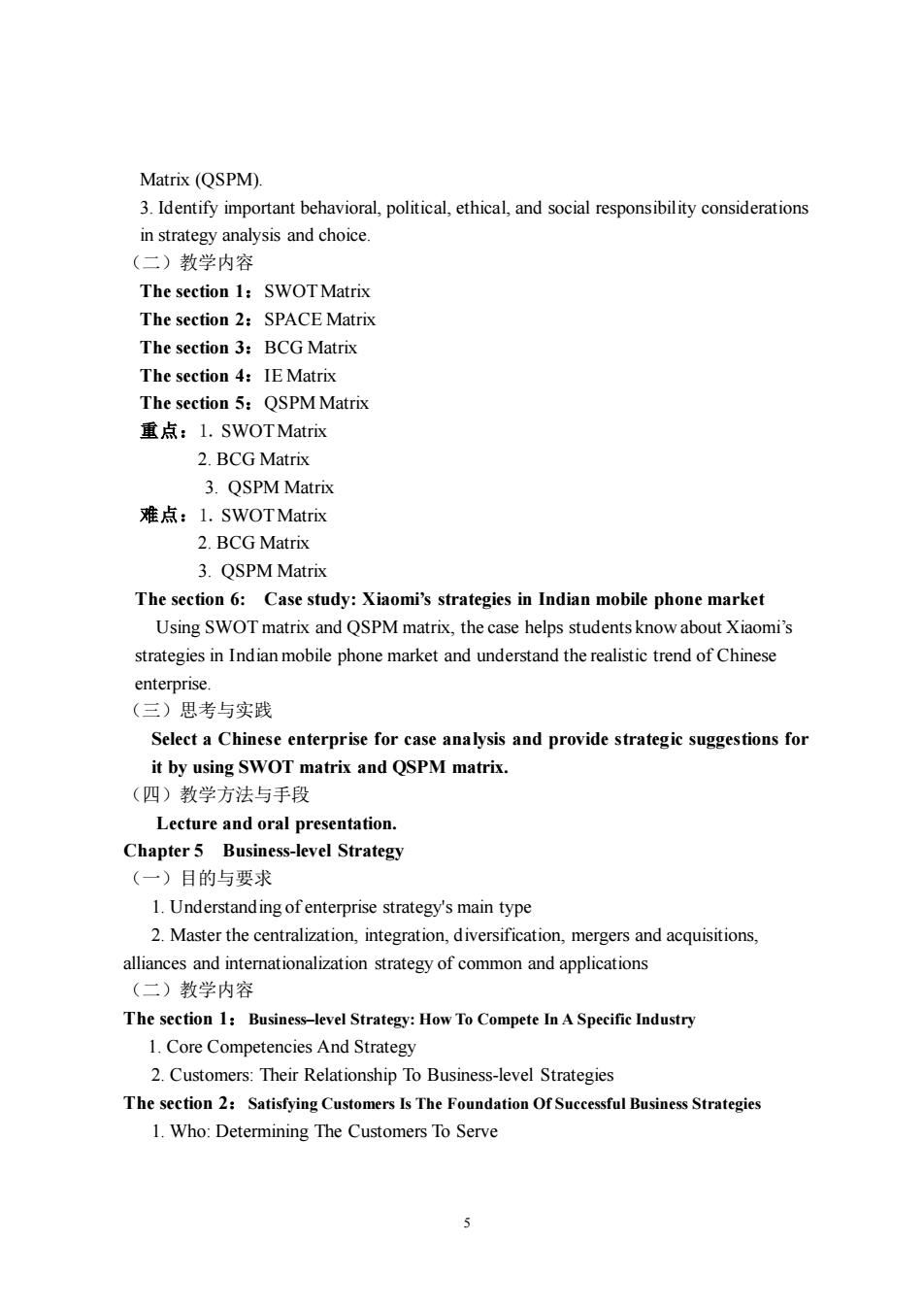
《国际战略管理》课程教学大纲 一、课程基本信息 课程代码:16169303 课程名称:国际战略管理 英文名称:International Strategic Management 课程类别:专业课 时:48 学分:3 适用对象:本科生 考核方式:考查 先修课程:西方经济学、国际贸易、市场营销 二、课程简介 中文简介: 《国际战略管理》是国际商务专业的核心课程之一。本课程是对国际市场营销管 理、跨国公司财务管理、国际物流与供应链管理、跨国人力资源管理等众多领域课程 的高度集成整合,可以引导帮助学生建立国际企业战略管理知识体系:在中国企业国 际化经营增加的趋势下,本课程突破了仅从国内角度分析问题的局限性,提供了培养 学生全球意识和引导帮助学生建立创新性思维模式的一个平台:本课程强调实践和应 用,这就使学习重点并不仅仅是掌握某些具体的理论或技术,而在于独立地、综合性 地解决企业国际经营中的问题,对本课程的学习可以引导帮助学生能灵活运用相邻学 科的基本概念、基本原理和基本方法及工具分析、解决问题,提高创新实践能力。 英文简介: <International Strategic Management>is one of the core courses of international business.This course is a highly integrated course in many fields,such as international marketing management,financial management of multinational companies,intemational logistics and supply chain management,transnational human resource management and so on.It can guide students to establish the knowledge system of strategic management of intemational enterprises.With the increasing trend of intemational operation of Chinese Enterprises,this course breaks through the limitation of analyzing problems only from domestic perspective.This course emphasizes practice and application,which makes the leaming focus not only on mastering some specific theories or technologies,but also on solving the problems in the international business of enterprises independently and comprehensively.The study of this course can guide and help students to make flexible use of them The basic concepts,basic principles,basic methods and tools of adjacent
1 《国际战略管理》课程教学大纲 一、课程基本信息 课程代码:16169303 课程名称:国际战略管理 英文名称:International Strategic Management 课程类别: 专业课 学 时:48 学 分:3 适用对象: 本科生 考核方式:考查 先修课程:西方经济学、国际贸易、市场营销 二、课程简介 中文简介: 《国际战略管理》是国际商务专业的核心课程之一。本课程是对国际市场营销管 理、跨国公司财务管理、国际物流与供应链管理、跨国人力资源管理等众多领域课程 的高度集成整合,可以引导帮助学生建立国际企业战略管理知识体系;在中国企业国 际化经营增加的趋势下,本课程突破了仅从国内角度分析问题的局限性,提供了培养 学生全球意识和引导帮助学生建立创新性思维模式的一个平台;本课程强调实践和应 用,这就使学习重点并不仅仅是掌握某些具体的理论或技术,而在于独立地、综合性 地解决企业国际经营中的问题,对本课程的学习可以引导帮助学生能灵活运用相邻学 科的基本概念、基本原理和基本方法及工具分析、解决问题,提高创新实践能力。 英文简介: <International Strategic Management> is one of the core courses of international business. This course is a highly integrated course in many fields, such as international marketing management, financial management of multinational companies, international logistics and supply chain management, transnational human resource management and so on. It can guide students to establish the knowledge system of strategic management of international enterprises. With the increasing trend of international operation of Chinese Enterprises, this course breaks through the limitation of analyzing problems only from domestic perspective. This course emphasizes practice and application, which makes the learning focus not only on mastering some specific theories or technologies, but also on solving the problems in the international business of enterprises independently and comprehensively. The study of this course can guide and help students to make flexible use of them The basic concepts, basic principles, basic methods and tools of adjacent

disciplines are used to analyze and solve problems and improve the ability of innovation and practice 三、课程性质与教学目的 了解国际战略管理的定义和相关的管理学理论,掌握战略制定、实施和评价的技 巧和内容,通过对配套案例的分析将理论与实际相结合,把各章的所学到的知识进行 应用,以达到学生在各种营利或非营利组织中进行战略制定、实施和评价的具体应用, 同时,在深度融入全球化进程的新阶段下,中国企业国际化经营中强调在当地实现制 度嵌入、文化嵌入、关系嵌入、生态嵌入等全面嵌入内容,强调对不同国家制度、市 场、文化等因素进行深入分析,以达到学生理解中国企业国际化经营模式、问题等现 状,树立家国情怀和养成中企业家精神。 四、教学内容及要求 Chapterl Introduction:International Strategic Management Concepts (一)目的与要求 1.Describe fundamental concepts and principles of strategic management 2.Know the historical development of many current strategic management theories relating to the operation of a business. 3.Identify current thoughts about strategic management trends that will be affecting strategic management and what business managers can do to prepare for these trends. (二)教学内容 The section 1:profile of the present stage of strategic management The section 2:the concept of corporate strategy and characteristics 1.Define strategic management 2.Characteristics of strategy The section 3:The elements of strategy and level 1.The elements of strategy 2.The level of the strategy 重点:l.The meaning and characteristic of strategy 2.The meaning of strategic management,the process and level 难点:l.The meaning and characteristic of strategy 2.The meaning of strategic management,the process and level The section4:Out-ward direct investment of China from2002to2018(中国对外直 接投资情况分析) Objective:Help students to know about the situation of Chinese out-ward direct investment Contents:Changes of Chinese out-ward direct investment from 2002 to 2018 2
2 disciplines are used to analyze and solve problems and improve the ability of innovation and practice. 三、课程性质与教学目的 了解国际战略管理的定义和相关的管理学理论,掌握战略制定、实施和评价的技 巧和内容,通过对配套案例的分析将理论与实际相结合,把各章的所学到的知识进行 应用,以达到学生在各种营利或非营利组织中进行战略制定、实施和评价的具体应用。 同时,在深度融入全球化进程的新阶段下,中国企业国际化经营中强调在当地实现制 度嵌入、文化嵌入、关系嵌入、生态嵌入等全面嵌入内容,强调对不同国家制度、市 场、文化等因素进行深入分析,以达到学生理解中国企业国际化经营模式、问题等现 状,树立家国情怀和养成中国企业家精神。 四、教学内容及要求 Chapter1 Introduction: International Strategic Management Concepts (一)目的与要求 1.Describe fundamental concepts and principles of strategic management 2.Know the historical development of many current strategic management theories relating to the operation of a business. 3.Identify current thoughts about strategic management trends that will be affecting strategic management and what business managers can do to prepare for these trends. (二)教学内容 The section 1:profile of the present stage of strategic management The section 2: the concept of corporate strategy and characteristics 1.Define strategic management 2. Characteristics of strategy. The section 3:The elements of strategy and level 1.The elements of strategy 2. The level of the strategy 重点:1. The meaning and characteristic of strategy 2. The meaning of strategic management, the process and level 难点:1. The meaning and characteristic of strategy 2.The meaning of strategic management, the process and level The section 4:Out-ward direct investment of China from 2002 to 2018(中国对外直 接投资情况分析) Objective: Help students to know about the situation of Chinese out-ward direct investment Contents: Changes of Chinese out-ward direct investment from 2002 to 2018

Characteristics of Chinese out-ward direct investment (regions.industries and modes) Chinese out-ward direct investment on OBOR(One Belt and One Road) (三)思考与实践 Gathering Strategy information on enterprises. (四)教学方法与手段 Lecture Chapter 2 the external environment analysis:opportunities,challenges and industrial competitiveness (一)目的与要求 1.To understand the extemal environmental analysis and analytical thinking 2.To master the main content of the macro and industry analysis and the various factors 3.Master porter's five forces model 4.To understand the key success factors affect enterprise competition behavior 5.To master the basic method ofextemal analysis 6.Master EFE and CPM matrix analysis method (二)教学内容 The section 1:The Strategic Management Process 1.General Environment 2.Industry Environment 3.Competitor Environment The section 2:The Physical Environment Segment 1.Opportunity 2.Threats The section 3:Industry EnvironmentAnalysis The section 4:Competitor Environment Analysis The section 5:Case study:Xiaomi in Indian mobile phone market Taking Xiaomi's interational operation in Indian mobile phone market as an example this case helps students understand the external environment faced by Chinese enterprises international operation 重点:L.Macro environment analysis 2.Industry and competitive environment analysis 3.The external environment analysis 4.Master EFE and CPM matrix analysis method 难点:L.Macro environment analysis 3
3 Characteristics of Chinese out-ward direct investment (regions, industries and modes) Chinese out-ward direct investment on OBOR (One Belt and One Road) (三)思考与实践 Gathering Strategy information on enterprises. (四)教学方法与手段 Lecture. Chapter 2 the external environment analysis: opportunities, challenges and industrial competitiveness (一)目的与要求 1.To understand the external environmental analysis and analytical thinking 2.To master the main content of the macro and industry analysis and the various factors 3.Master porter's five forces model 4. To understand the key success factors affect enterprise competition behavior 5. To master the basic method of external analysis 6. Master EFE and CPM matrix analysis method (二)教学内容 The section 1:The Strategic Management Process 1.General Environment 2.Industry Environment 3. Competitor Environment The section 2:The Physical Environment Segment 1.Opportunity 2.Threats The section 3:Industry Environment Analysis The section 4:Competitor Environment Analysis The section 5: Case study: Xiaomi in Indian mobile phone market Taking Xiaomi's international operation in Indian mobile phone market as an example, this case helps students understand the external environment faced by Chinese enterprises' international operation. 重点:1. Macro environment analysis 2. Industry and competitive environment analysis 3. The external environment analysis 4.Master EFE and CPM matrix analysis method 难点:1. Macro environment analysis

2.Industry and competitive environment analysis 3.The external environment analysis 4.Master EFE and CPM matrix analysis method (三)思考与实践 Developing an EFE Matrix for enterprises. (四)教学方法与手段 Lecture and oral presentation. Chapter 3 the internal environment resources,capabilities,competencies and competitive advantage (一)目的与要求 1.To understand the purpose and significance of the internal environment analysis 2.The definition and distinguish the concept of the resources 3.Understanding the connotation of enterprise core competitiveness and standards 4.Mastering the IFE matrix analysis method. (二)教学内容 The section 1:Competitive Advantage Sustainability The section 2:Analyzing The Internal Organization 重点:L.Enterprise resources and capabilities 2.Enterprise value chain 3.Enterprise core competitiveness 4.Internal environment analysis of IFE matrix analysis method 难点:L.Enterprise resources and capabilities 2.Enterprise value chair 3.Enterprise core competitiveness 4.Interal environment analysis of IFE matrix analysis method (三)思考与实践 Performing a Financial ratio analysis for enterprises (四)教学方法与手段 Lecture and oral presentation. Chapter 4 Strategy Generation and Selection (一)目的与要求 1.Describe a three-stage framework for choosing among altemative strategies 2.Explain how to develop a Strengths-Weaknesses-Opportunities-Threats (SWOT) Matrix,Strategic Position and Action Evaluation (SPACE)Matrix,Boston Consulting Group (BCG)Matrix,Internal-External (IE)Matrix,and Quantitative Strategic Planning 4
4 2. Industry and competitive environment analysis 3. The external environment analysis 4.Master EFE and CPM matrix analysis method (三)思考与实践 Developing an EFE Matrix for enterprises. (四)教学方法与手段 Lecture and oral presentation. Chapter 3 the internal environment resources, capabilities, competencies and competitive advantage (一)目的与要求 1. To understand the purpose and significance of the internal environment analysis 2. The definition and distinguish the concept of the resources 3. Understanding the connotation of enterprise core competitiveness and standards 4. Mastering the IFE matrix analysis method. (二)教学内容 The section 1:Competitive Advantage Sustainability The section 2:Analyzing The Internal Organization 重点:1. Enterprise resources and capabilities 2. Enterprise value chain 3. Enterprise core competitiveness 4. Internal environment analysis of IFE matrix analysis method 难点:1. Enterprise resources and capabilities 2. Enterprise value chain 3. Enterprise core competitiveness 4. Internal environment analysis of IFE matrix analysis method (三)思考与实践 Performing a Financial ratio analysis for enterprises. (四)教学方法与手段 Lecture and oral presentation. Chapter 4 Strategy Generation and Selection (一)目的与要求 1. Describe a three-stage framework for choosing among alternative strategies. 2. Explain how to develop a Strengths-Weaknesses-Opportunities-Threats (SWOT) Matrix, Strategic Position and Action Evaluation (SPACE) Matrix, Boston Consulting Group (BCG) Matrix, Internal-External (IE) Matrix, and Quantitative Strategic Planning

Matrix(OSPM. 3.Identify important behavioral,political,ethical,and social responsibility considerations in strategy analysis and choice. (二)教学内容 The section 1:SWOTMatrix The section 2:SPACE Matrix The section 3:BCG Matrix The section 4:IE Matrix The section 5:QSPM Matrix 重点:L.SWOTMatrix 2.BCG Matrix 3.OSPM Matrix 2.BCG Matrix 3.QSPM Matrix The section 6:Case study:Xiaomi's strategies in Indian mobile phone market Using SWOTmatrix and QSPM matrix,the case helps students know about Xiaomi's strategies in Indian mobile phone market and understand the realistic trend of Chinese enterprise (三)思考与实践 Select a Chinese enterprise for case analysis and provide strategic suggestions for it by using SWOT matrix and QSPM matrix. (四)教学方法与手段 Lecture and oral presentation. Chapter5 Business-level Strategy (一)目的与要求 1.Understanding ofenterprise strategy's main type 2.Master the centralization,integration,diversification,mergers and acquisitions. alliances and interationalization strategy of common and applications (二)教学内容 The section 1:Business-level Strategy:How To Compete In A Specific Industry 1.Core Competencies And Strategy 2.Customers:Their Relationship To Business-level Strategies The section 2:Satisfying Customers Is The Foundation Of Successful Business Strategies 1.Who:Determining The Customers To Serve 5
5 Matrix (QSPM). 3. Identify important behavioral, political, ethical, and social responsibility considerations in strategy analysis and choice. (二)教学内容 The section 1:SWOT Matrix The section 2:SPACE Matrix The section 3:BCG Matrix The section 4:IE Matrix The section 5:QSPM Matrix 重点:1. SWOT Matrix 2. BCG Matrix 3. QSPM Matrix 难点:1. SWOT Matrix 2. BCG Matrix 3. QSPM Matrix The section 6: Case study: Xiaomi’s strategies in Indian mobile phone market Using SWOT matrix and QSPM matrix, the case helps students know about Xiaomi’s strategies in Indian mobile phone market and understand the realistic trend of Chinese enterprise. (三)思考与实践 Select a Chinese enterprise for case analysis and provide strategic suggestions for it by using SWOT matrix and QSPM matrix. (四)教学方法与手段 Lecture and oral presentation. Chapter 5 Business-level Strategy (一)目的与要求 1. Understanding of enterprise strategy's main type 2. Master the centralization, integration, diversification, mergers and acquisitions, alliances and internationalization strategy of common and applications (二)教学内容 The section 1:Business–level Strategy: How To Compete In A Specific Industry 1. Core Competencies And Strategy 2. Customers: Their Relationship To Business-level Strategies The section 2:Satisfying Customers Is The Foundation Of Successful Business Strategies 1. Who: Determining The Customers To Serve